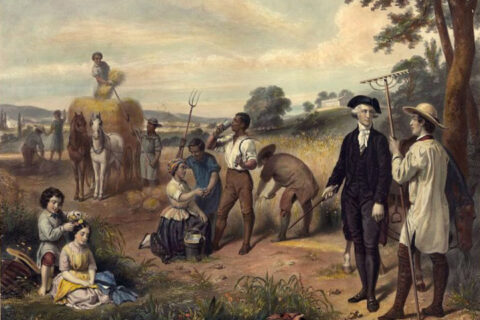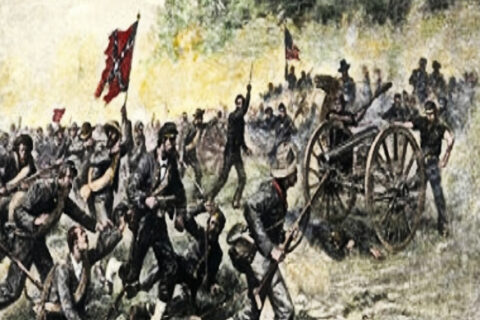This essay stands as the second entry in my Great Statesmen of Dixie Series and will take us into the great Republic of Texas.
The Lone Star State’s reputation precedes it. A once notoriously conservative Southern Democrat state, Texas formed as a crossover between the Deep South, Appalachia, and the West. As such, it developed a multifaceted Jim Crow system to compensate for both its Negro and Hispanic populations. Ruled primarily by its eastern regions, Texas remained deeply Southern in politics and culture with a cowboy twist, a culture which still exists in the largely carpetbagger and immigrant infested land to this day. Arguably the state’s best and most preeminent governor of its history, Allan Shivers, laid the groundwork for resistance to the unconstitutional demands of the federal government to desegregate its public-school systems and facilities. This essay will cover the life and political career of Allan Shivers.
Robert Allan Shivers was born on October 5, 1907, in Lufkin. Of a poor background, his family originally hailed from Mississippi, his grandfather, Robert, having served in Company B, 16th Mississippi Infantry Regiment. Being reared primarily in Woodville and Port Arthur, Shivers’ political philosophy was heavily influenced by the indigence he spent his youth around during his time in Woodville, in addition to his financial difficulties he faced following his graduation from the University of Texas at Austin with a law degree. Further contributing factors to his conservative political development would have been his Baptist beliefs, as well as the exorbitantly wealthy family he married into through Marialice Shary, the latter of which led to his acquisition of the prosperous plantation named Sharyland.
Despite being of a conservative foundation, Shivers surprisingly won a seat to the Texas State Senate from a liberal, pro-union district in 1934, becoming the youngest state senator elected in Texas up to that point in its history. Through political tact and crafty language, Shivers managed to accrue votes from such an ideologically opposing area while still appearing as a moderate, not allowing his true beliefs to be widely known. For example, he publicly maintained neutrality regarding the New Deal but personally opposed it. Holding the seat until 1946, Shivers briefly stepped away from the state assembly when he commissioned into the U.S. Army in 1943 during World War II, being discharged with the rank of major in 1945.
Upon his return to Texas and resumption of his public service, the Texas Democratic Party was deeply fractured. The 1930s and 1940s saw the national Democrats undertake a more liberal agenda, going so far as to begin pushing Civil Rights legislation and discussion alongside the highly divisive New Deal economic policies. Texans fractured into the economically liberal union members, staunch party loyalists who endorsed a moderate approach to politics and preferred obeying the law above all else, various Hispanic and Negro organizations in south and east Texas respectively, the conservative pro-business section, and the rightwing segregationists and anti-communists. In 1944, a group of Democratic leaders formed a Texas Democrat faction called the Texas Regulars and sought to deprive the increasingly tyrannical President FDR the electoral votes from the state, the first instance of Southerners attempting to break away from the Democratic Party. Though the Regulars failed, the seeds of discontent had already been sown, and this is the condition of politics Major Allan Shivers returned to at the end of the war.
Not long after his return, Shivers ran for and won the lieutenant governor election in 1946 and won re-election in 1948. His time in the position established a precedent for the role. He worked diligently within the role to exert influence and greatly expanded many of the powers of the Lieutenant Governor of the state, stretching them as far as the Texas Constitution would allow. Throughout his term as Lieutenant Governor, his party remained fractured. This division grew emphatically during the tenure of President Harry Truman. Although Texas’ Governor Beauford Jester and Lieutenant Governor Shivers neglected to support the Strom Thurmond and Fielding Wright ticket for the States’ Rights Democratic Party during the 1948 presidential election, many powerful Texans did; and this even planted more seeds for the breakdown of the Texas Democrats, similar to the actions of the Texas Regulars.
Shivers ascended to the governorship in 1949 following the sudden death of Beauford Jester. While he had progressively showcased his conservative, rightwing beliefs as he climbed the political ladder, it was during this time he fully unveiled his true sentiments. It was from 1949 to 1950 that he sought to reconsolidate the Texas Democrats and seize the political machinery for himself. A party convention was held in 1950 to determine just who exactly would chair the powerful State Democratic Executive Committee (SDEC). Shivers, through crafty political maneuvering, ensured many conservatives, some of them former Regulars and Dixiecrats, controlled the committee. In order to rally some liberals to support him at the party convention, he claimed stalwart party loyalty. It was also during this same year that Shivers won election to his first full term as governor. The stage had been set, and his move to control the SDEC shocked many moderate and liberal party loyalists.
Thenceforth from 1950, Shivers stood as one of Dixie’s most powerful state leaders and ruled the state of Texas with superfluous popularity. Leading a conglomeration of conservatives, Texas Regulars, and Dixiecrats, Shivers’ faction became known as the Shivercrats and battled bitterly against the growing faction of liberals and Civil Rights advocates in his state. He was so dedicated to battling the growing leftism within the national party that he led Texans to vote for Republican candidate General Dwight Eisenhower against Democrat Adlai Stevenson II during the 1952 presidential election. This election led to the early move of Texas permanently towards the Republican Party. It was also during 1952 he engaged in a malicious gubernatorial campaign against liberal Houstonian challenger Ralph Yarborough. The run was so vicious, in fact, that the two openly loathed one another for the rest of their lives. Shivers expressed frequent frustration with the liberal takeover of the Democratic Party. At one point in a speech given to the SDEC, Shivers stated in a superb moment of speechcraft:
“Our First Political Loyalty is the Free and Independent Democratic Party of Texas as the unshackled guardian for more than a century of true Texas traditions of Democratic government and as the protector and promotor of the best interests of our commonwealth, its people, and its principles. We repudiate as alien to our heritage and foreign to our freedom those self-appointed and self-seeking serfs of a corrupt national political machine who under the self-styled label of ‘loyal’ presently seek to prostitute the power and pillage the opportunity of Our Texas Democratic Party to aid in recapturing and redeeming the National Democratic Party from left-wing domination and machine control. I scorn the suggestion that ‘loyalty’ demands an abject, contemptible, and unconditional surrender in advance to the whims or the dictates of any absentee overlords of the national party. The self-governing and self-respecting Democratic Party of Texas, which nurtured the still small light of the Party of Jefferson and Jackson for fifty years during which it was extinguished in darkness in the North and East, does not slink and cower, hat in hand, to anybody’s back door to make a blind trade of our heritage for a handout.”
Shivers finally left office and public life in 1956, opting not to run again even though he most likely would have won. His popularity was unwavering during his term, even so far as to be listed on both the Republican and Democratic ticket in the 1952 election.
His fight against the Civil Rights Revolution and communism garnered national attention and an unprecedented amount of success. While he did successfully balance the budget and bring order to a politically divided state, it is this sphere of his tenure which garnered him the most recognition, including his political actions in the 1952 presidential election. Alongside his alliance with other Deep South segregationists and his aforementioned appointing and raising of various Regulars and Dixiecrats to powerful positions, Shivers relentlessly and ceaselessly railed against communism which had deeply infiltrated the United States at that time, and which spearheaded the Civil Rights push. His ceaseless crusade against these forces came to a head following the unconstitutional Brown v Board of Education ruling. Though a staunch segregationist beforehand, his rhetoric only grew louder thenceforth. His most infamous act of opposing integration occurred in 1956. Texas having not yet integrated its schools, the U.S. Fifth Circuit Court of Appeals ordered Texas to desegregate Mansfield High School in the Jackson v Rawdon case. During an attempt to enroll some Negro students, Governor Shivers ordered the Texas Rangers, under the command of Captain Jay Banks, to prevent the integration attempt. It was successful and marked the very first time a state resisted the Brown v Board desegregation order. This event set a precedent and inspired the rest of Dixie to do the same. Mississippi certainly followed Texas’ lead here, and the Mansfield incident directly led to Orval Faubus’ actions during the integration of Little Rock High School. This single event is the most notorious and influential moment of Shivers’ career, alongside catalyzing the rise of the Republican Party of Texas.
Governor Allan Shivers led a fascinating and pivotal career. Setting out from humble beginnings, he won in a surprise election to the state senate, commissioned into the U.S. Army and served in World War II, returned home and rose to the lieutenant governorship, and finally ascended to the governorship, becoming the most powerful governor of Texas up until that point in its history and serving record setting four terms. Furthermore, Shivers’ actions set the standard for Southern resistance to the Civil Rights Movement. Though largely faded out of public knowledge because of modern historians purging Southern history, Allan Shivers stood as a truly superlative statesman and left in his wake a permanent impact for the behaviors and powers of future governors.
As a final testament to the governor’s character, it cannot go without mention that he continued the tradition of leaving a Holy Bible marked with a verse on the table of the governor’s office begun by previous Texas Governor Pat Neff in 1925. Shivers’ verse of choice for his successor, Price Daniel, was Philippians 4:6, “Be careful for nothing; but in everything by prayer and supplication with thanksgiving let your requests be made known to God.“
Bibliography
- Dobbs, Ricky F. Yellow Dogs and Republicans Allan Shivers and Texas Two-Party Politics. College Station, TX: Texas A&M University Press, 2005.
“The White people of the South are the greatest minority in this nation. They deserve consideration and understanding instead of the persecution of twisted propaganda.” –Strom Thurmond






Very good and balanced article about one of the few outstanding conservative leaders of mid-20th century America.
I am a cousin of the Governor and namesake of his grandfather, Robert M Shivers.
He was indeed a great hero of Texas. Compare him to this spineless cripple we Texans are stuck with today, who won’t even secure the border on the Rio Grande and has no problem letting in tens of thousands of filthy third world aliens (the vast majority of whom are young fighting-age males), so long as it doesn’t harm the profits of these greedy exploitative global corporations that have decided to use Texas as their home base (muh free market capitalism).
Here in DFW (mainly Dallas, less so Fort Worth), it is a compete cesspit. It’s filled with greedy liberal left capitalists, filthy degenerate reprobate queer perverts, and smelly dark-brown third-world Indian immigrants. Dallas Love Field even took down the statue of Capt. Jay Banks during the 2020 Bolshevik Lives Matter riots.
What has become of Texas in only the past recent years is far worse than even the worst thing Gov. Shivers would’ve ever thought of in his time. The Anglo population of Texas is already being eclipsed by the Latin (primarily Mexican) population of Texas. Maybe it’s only a matter of time before Texas does indeed get reclaimed by Mexico (which, in comparison with this Judeo homo/tranny/pedo satanic federal regime in Washington DC, would be way better, but still bad). The Anglo-Frontier Western Cowboy identity that Texas is stereotypically known for around the world must be preserved, and the only way it can be is through Texas secession and Independence.
Anyway, thanks for taking the time to write and share this, Long Live the Republic of Texas.
https://www.youtube.com/watch?v=Uh2lLz4x3Hs
Fascinating indeed. Always enjoy these deep dives brother.
Loved it.Great learning about heros to our cause.May the good Lord bless and keep you.